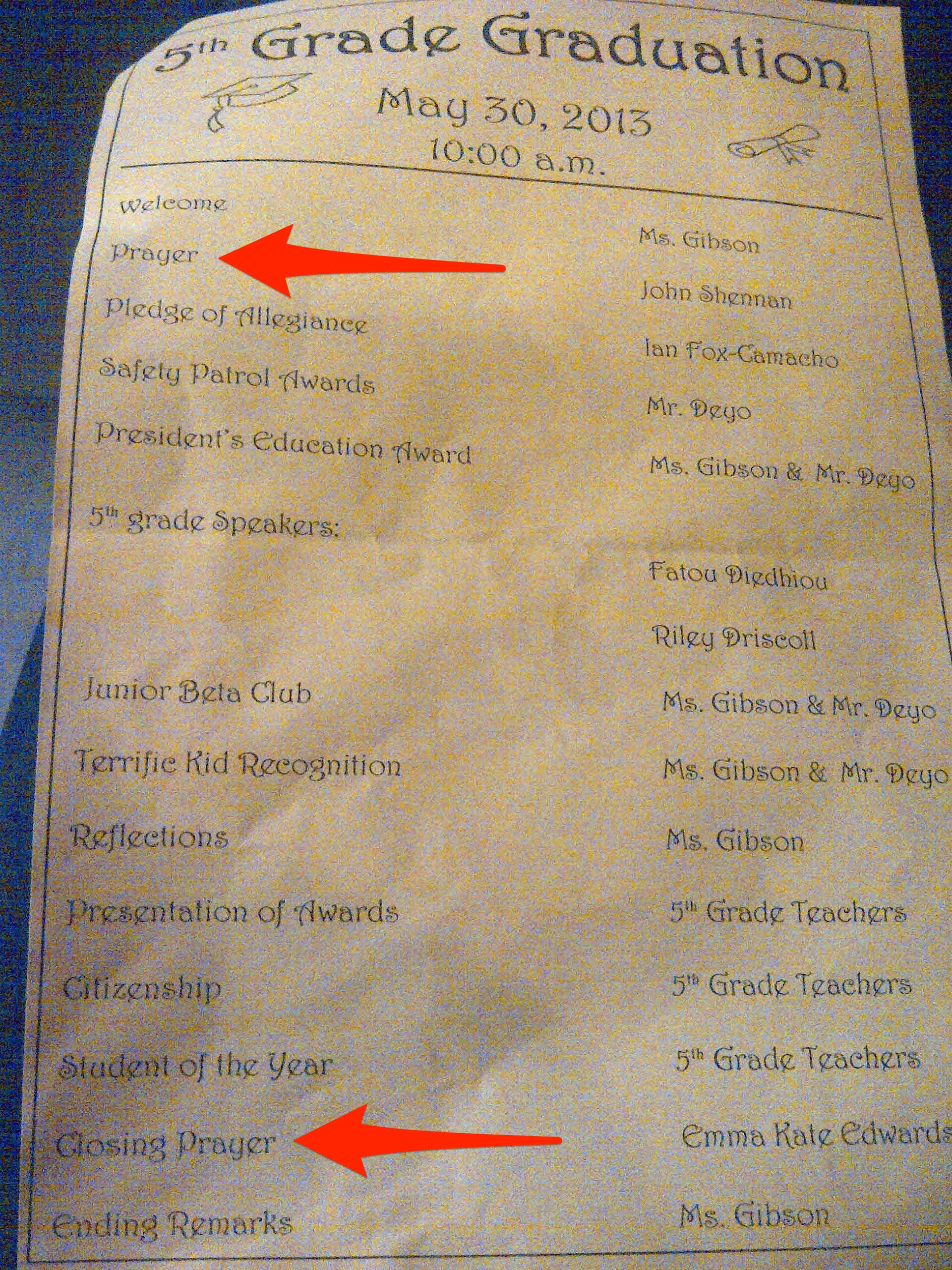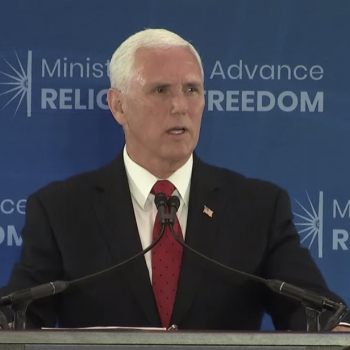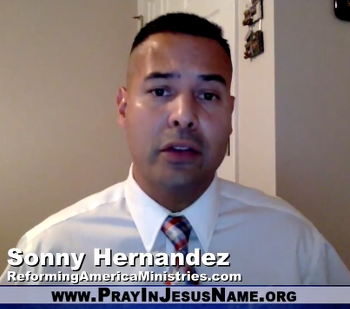A federal court has stepped in to block a South Carolina school district from including Christian prayers at graduation ceremonies. It’s the culmination of a six-year battle that could have been resolved much more quickly if the school officials weren’t so eager to push God onto those audiences.
The battle really began six years ago, when administrators at Mountain View Elementary School in the city of Taylors held a “graduation” ceremony inside of a church.

Maybe they could’ve gotten away with that — other public schools have held ceremonies in similar places — but the event’s program didn’t even attempt to shy away from promoting Christianity, listing two separate prayers right in the program.

School officials didn’t just cross the line. They destroyed the line.
The American Humanist Association’s Appignani Humanist Legal Center sent the District a letter at the time warning them of the consequences of holding future ceremonies in the same location with these prayers. The District said they wouldn’t “endorse” prayers in the future, but implied that student-initiated prayer would be okay… which might be fine, except in this particular case, a school official had asked a student to deliver the first prayer.
The response also left open a giant loophole: Administrators could always ask students to speak (*wink wink nudge nudge*), knowing that the student population was overwhelmingly Christian and would pray on their own. Considering that these ceremonies were held inside of a church, that gave students even more encouragement to recite a prayer in their speeches. (Hell, that could be part of the reason those students were selected.)
In September of 2013, the AHA filed a federal lawsuit on behalf of the family of a Mountain View Elementary student against the Greenville County School District and multiple administrators claiming that the District violated the Establishment Clause through their actions.
“The federal courts have been clear that events like these violate the constitutional principle of separation of church and state,” said Monica Miller, an attorney and legal consultant with the Appignani Humanist Legal Center. “Any event sponsored by a public school must not violate that principle.”
They also pointed out the problem with the venue. When there are alternative, acceptable spaces for an elementary school graduation readily available, there’s no reason to hold it in a church on a Christian campus with a motto like “Christ makes the difference” and a logo like this:

The initial ruling came down in May of 2015, and it was all kinds of messed up.
U.S. District Judge Bruce Howe Hendricks said there was no evidence of anything illegal going on and that the District “ha[d] gotten it exactly right.”
She added that the AHA was right about the illegality of the prayer policy prior to 2013, but didn’t go that far with regards to prayers at future graduation ceremonies since they would be student-initiated. Furthermore, the judge said the family filing the lawsuit didn’t have proper standing to bring the case. (She didn’t say anything about the church venue for the ceremonies.)
The AHA appealed the decision. That ruling, in June of 2016, was good news all around because it corrected the mistakes of the earlier court.
The judges threw out the earlier decision and said the standing issue needed to be reassessed since the AHA had other plaintiffs who satisfied that requirement. They also said the courts would have to rule on the merits regarding the location of the ceremony. They couldn’t ignore it anymore.
So the AHA got a second chance to make its case, and they took advantage of it. In December of 2017, the same lower court judge, Bruce Hendricks, ruled in their favor.
In the case of whether graduation should have been held in a chapel? Hendricks said the District never should have done that.
The fact that the district chose to hold the ceremony (which included school-endorsed Christian prayers) in a clearly Christian place of worship in the presence of religious iconography, including, among other things, a cross on the podium and eight stained glass windows depicting Christian imagery, only further created a likelihood that observers would perceive the district as endorsing a particular set of religious beliefs. There has been no showing that the chapel was the only available venue for the graduation ceremony, and in view of the overall circumstances of the event, there can be no doubt that the setting in which the ceremony occurred conveyed a message of religious endorsement and created a likelihood that the school-aged children would perceive a link between church and state.
What about the wink-wink-nudge-nudge “student-initiated” prayers in the future? Hendricks said the policy may be legal in theory, but perhaps not so in practice because of all the winking. She allowed both sides a couple of months to settle their differences on their own. If there was evidence the District was still pushing religion on students after all of that, the AHA was free to sue again.
Unfortunately, nothing really changed. The coercive aspect of those prayers was still there, leading the AHA to sue again last August.
In the memorandum filed today, the AHA provided overwhelming evidence (supported by over 70 exhibits) showing that the district is continuing to subject captive student audiences to graduation prayers, contravening Supreme Court precedent, and even violating the terms of the 2015 injunction by using religious language in written programs, encouraging students to pray, and asking audiences to stand for explicitly Christian prayers. “The school district has demonstrated it is either unable or unwilling to respect the constitutional rights of religious minorities, requiring serious court intervention,” [attorney Monica] Miller stressed.
The documents they filed were lengthy, but it was easy to see the overwhelming amount of evidence the AHA had suggesting prayer was still being promoted in the District.
Maybe the most glaring example was how some schools replaced “Invocation” with “Opening Remarks” in their graduation programs… even though they still had “a separate, redundant ‘welcome'” in the schedule.
Why have two “welcomes”… unless one of them was always meant to be a prayer?
Yesterday, Judge Hendricks issued his latest ruling in this case, admitting that “the district’s current practices are not completely neutral toward religion.” There are still prayers at graduation, and some of the programs still tell people to stand for students’ remarks!
The District said it was a mistake. But at this point, does anyone really believe that?
… the Court finds that asking a captive audience to stand while a student delivers a prayer indicates that the district’s revised policy as implemented has not effectively ameliorated the district’s longstanding practice of including formal or official prayers at graduation ceremonies.
Furthermore, even if the prayers are now student-initiated, the judge said that District officials still check the messages in advance for “time, grammar, and syntax.” So even if content isn’t reviewed, the administrators know well in advance that prayer will be in the ceremonies. There’s a measure of oversight by the officials that shouldn’t be there if they really want to remain neutral.
To that end, because the District can’t be trusted to do the right thing on its own, the judge created very specific guidelines for school officials to follow. I’m paraphrasing them below:
1) No prayers can be listed in the official graduation programs — and no euphemisms (like “inspirational reading”) either.
2) School officials can’t encourage prayers during graduation ceremonies in any way.
3) If students speak at graduation, they must be chosen under religiously neutral criteria that’s listed in writing.
4) School officials can’t give those kids copies of old remarks as a template for their own.
5) The parts of the graduation ceremonies that involve student messages must be printed the same way for every school in the District. (That way, one school can’t make a “mistake.”) And none of those programs should direct the audience to stand during students’ remarks.
6) If administrators see the students’ speeches in advance for any reason, they must make sure prayers aren’t in them.
7) Students who wish to include prayer in their speeches cannot ask the audience to participate with them (like by standing or bowing their heads). And if there is prayer in the students’ speeches, school officials cannot join in.
8) All graduation programs that include students’ remarks must say, “The views or opinions expressed by students during this program are their own and do not reflect the policy or position of the school District.”
9) District officials must give administrators at each school a copy of these guidelines in writing, and those administrators must give the guidelines to student speakers as well.
It’s incredible, really, how the judge has to treat these administrators like babies, giving them a step-by-step playbook for how to follow the law since those adults can’t seem to get it right on their own.
A much simpler solution would be to just eliminate student speakers at these ceremonies and remind officials not to pray. But all of this is happening because the District just won’t do enough to prevent coercive Christian prayers from ruining these ceremonies.
It’s not clear what the punishment will be if the District doesn’t follow these rules. Still, the AHA is pleased with the outcome.
“We are thrilled that the court is finally putting an end to flagrant school-sponsored prayers and Christian hymns at public school graduation ceremonies,” said Monica Miller, AHA senior counsel and lead attorney in the case. “This was a long fight for justice for students who do not wish to encounter government-sponsored religion at their own graduation ceremonies.”
…
“The school district subjected countless students to school-sponsored prayers on what should otherwise be a celebratory and inclusive occasion for all students, religious or not,” said Roy Speckhardt, executive director of the AHA.
(Image via Shutterstock. Large portions of this article were published earlier)




It’s Moving Day for the Friendly ..."
It’s Moving Day for the Friendly ..."
It’s Moving Day for the Friendly ..."
It’s Moving Day for the Friendly ..."